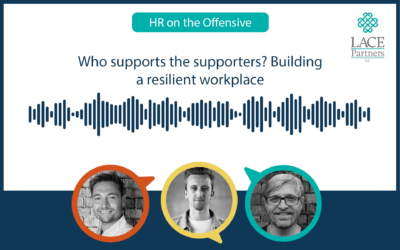Earlier this year we were asked to give our view on a perspective that an optimal number of employees per line manager was between eight to ten. But with leaders not in the same room, should this be reduced? We reflected on this in a piece featured the HR Director magazine and online. You can read the article itself here. In today’s blog we want to expand on some of these points – more of a ‘deep dive – looking at how Organisational Design (OD) might evolve in 2022 and beyond and have followed on from the HR Director article with some more thoughts.
Setting the OD scene
Over the past 18 months, the COVID-19 pandemic has not only swept across the globe, but it has transformed the workplace. The use of global lockdowns to quell the spread of the virus changed the primary location of many employees, while changing how organisations and their hierarchies existed. Companies needed to adapt rapidly to this change – or face losing out to competitors. Organisational design (OD) is the glue that brings together a company’s strategy and the reality of making it happen. It’s the linchpin of how an organisation works. It informs the basics like the planning of office space through to the structure of leadership. Done well, it should be the physical re-enforcement of your culture. OD allows businesses to work smoothly, consistently and with clarity towards their purpose. The pandemic period saw meetings shift online, employees distributed across the country (or countries in some cases) – it meant traditional hierarchal structures were challenged or erased. Overall, businesses have managed to adapt to this ‘new normal’. They have found that they can move quickly if needed, and that they can be productive while apart. Many organisations want to keep this agility in a post-pandemic workplace, particularly in the form of hybrid working. Most large employers have said they won’t insist on staff coming back to the office, which means the workplace dynamic has changed and when looking at OD, this is a key consideration for HR teams. Some businesses have fallen into administration, some have rebuilt, diversified, reconnected and reskilled furloughed workers. Others are seeing rapid growth, like the insurance and technology sectors, and for these businesses the focus is on talent attraction and securing market share, whilst catering for employee needs, in a way that drives the productivity and purpose of the organisation forward.
Designing for collaboration
Any businesses assessing their organisational design must ensure they have communication, collaboration and accountability at the heart of their aims. Remote working has driven creative collaboration (tools like Mural and Trello, for example) but maintaining that in to 2022 is a huge challenge that every hybrid or remote business now faces, especially given the increase in press around the impacts on employee wellbeing around remote working. The key to success will be when an organisation can find the right approach to integrating these collaborative tools so that the benefits can maintain whilst the hybrid world of work begins to become normality. Collaboration tools have enabled us to all reach out to each other quicker and with more simplicity, whilst also giving everyone a voice when you have a wider number of people in meetings virtually, for example, but they have also enabled us to widen our pool of talent. But online and digital collaboration can only get you so far. Collaborating over video call is not the same as having a flip chart in a meeting room and bouncing ideas off each other and can’t create the cross pollination of ideas and dialogue in the same way as physical interaction Therefore it is important to be clear on the ground rules to ensure effective collaboration. When working across different locations, why not, for instance, develop some guidelines as to which meetings will only be held when people are either fully face-to-face or fully digital?
Planning physical workspaces
Related to collaboration is office space. With many employees happy to work remotely, the function of the office building becomes about face-to-face tasks, such as a sales pitch or a brainstorming meeting. With this in mind, we are already seeing businesses changing their view on their own workspaces – either by cutting them or by completely redesigning them (think more collaborative meetings rooms and less individual desk space). For many businesses, many employees need to be physically present, so it’s important to design a central function that reduces any feeling of a two-tier, them-and-us situation. Generally, businesses need to consider what remote, office and site locations will be used for and then ensure those spaces work for those purposes.
Retaining the human connection
Another factor to consider is connectivity. With businesses cutting their office space, and potentially redesigning to gain more co-working spaces, is there a minimum face-to-face requirement? Or given the potential for video call fatigue, a maximum video call limit? For many, working remotely has humanised co-workers in ways that would have been inconceivable before. The window into someone’s home provides colour in their life that is often lacking in the workplace. It provides connection. Organisational design needs to factor in support mechanisms and ways of connecting people who have suffered from isolation. This should involve informal, social functions to formally create communities of practice – people who do not report directly to each other but work together.
Getting the balance right
Teams also need to consider connection outside the office – in the form of work-life balance. The time not spent on a commute this past year has for some been redistributed to home workouts, spending time with kids, or sleeping in. Many employees have enjoyed this change in pace. Insurance company Aviva has said after the past year, 95% o f its workers want to spend some of their working hours either remotely or flexibly. Burnout from the lack of separation from home and work life, or working in an unsafe environment, or one with limited workspace, are all considerations that must also be factored in for HR leaders. Organisations need to consider the needs of all their employees and whether the changes over the past year have worked towards the good of their people and overall purpose.
Retaining a responsive and agile leadership structure
This connectivity also needs to be managed within the leadership structures of the OD. In the HR Director article we were asked if – prior to COVID-19 – there was a view that the optimal number of subordinates per line manager was between eight and ten, whether this number needs reviewing. We think it does. By half. When leaders are spread location-wise away from their people, it is hard to give time effectively, creating a disconnect between colleagues if staff are not getting adequate support. In most cases, people still leave their managers – not the business – so OD can support line managers, so they are as effective as possible. Look at the question of governance too. Leaders need to recognise that during the pandemic one of the benefits of being forced to change was that businesses were able to try things that ordinarily they may not have, for fear of the risks. Post-pandemic businesses will need to sustain the quick decision making that has been practiced over the last year and a half.
New organisational design driving people policy reviews
Policies also need to be revisited in the new world we live in, adapting to the new ways of working, or else become a liability for businesses. Most contracts from pre-pandemic times will not include remote or hybrid working policies or terms. Requests to work abroad must be considered in the context of potential tax liabilities and if restrictions need to be put in place. If employees need to come to the office, there also needs to be a clear policy around who pays, because a contract stipulating a home worker could result in confusion on whether expenses are needed for travel. Pre pandemic this would have been less of a consideration than in the current world of work. If a business is based in London or a major city, there has also been questions around hiring people from a wider geographic area – are you still paying London weighting if an employee isn’t required to be in London? These are all nuanced questions that need to be considered, which is why active listening and working closely with your employee base is critical. You can only put in place effective and efficient OD if you have this.
Preparing for continued change
The future of the workplace is unknown for many businesses and finding a new OD will require testing the solutions that have potential to support the purpose of the business. It will not be a quick fix. Nor will it be an OD that lasts for 25 years. It will need to be flexible and agile. The new method of working will take time to develop, and if it’s not right, then it will need to adapt. The scale of change over the pandemic has been immense. But what we’re all learning is that change is still coming. Now, it’s about learning how to move forward, grow and remain resilient throughout whatever’s next.






